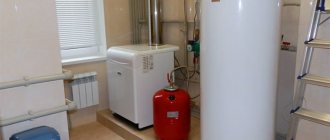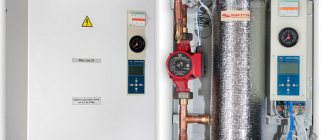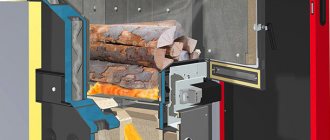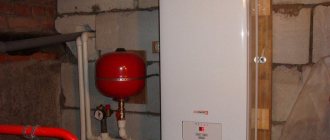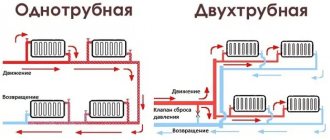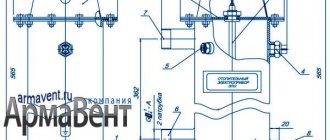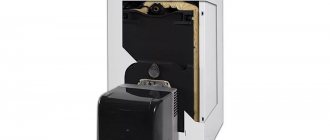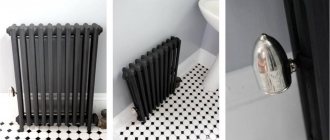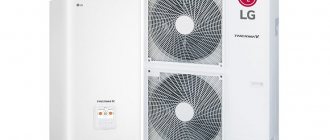Electric boilers are almost ideal from a practical point of view. They do not require the installation of a chimney, the organization of proper ventilation, and imply a minimum of communications around them. However, operating costs when heating with electricity are among the highest: many times higher than when heating with gas, wood or coal. Heating a house with an area of 80 square meters can cost up to 9-10 thousand rubles per month.
It is also worth considering that an electric boiler for heating a house with an area of 80 square meters is a powerful unit that requires connection to a three-phase network (380 V), since a single-phase (220 V) will not be able to operate at full power.
Requirements for boilers for heating a private house with an area of 80 sq.m.
Manufacturers produce devices in accordance with GOST standards. The equipment must meet safety requirements.
Depending on the model, electric boilers are equipped with a circulation pump, expansion tank, and heating block. The package should include a pressure gauge, a thermometer for measuring pressure and water indicators.
The devices also have an air vent and a safety valve. In case of malfunctions, the equipment should automatically turn off or give a special signal.
Rating of TOP 7 best models
| Place | Name | Price |
| TOP 7 best electric boilers for heating a house at 220V | ||
| 1 | Protherm Scat RAY 12 KE/14 kW | 34 000 ₽ |
| 2 | EVAN Warmos-IV-9.45 9.45 kW | 22 000 ₽ |
| 3 | EVAN Next 7 7 kW | 10 000 ₽ |
| 4 | ZOTA 9 Lux 9 kW | 18 000 ₽ |
| 5 | Vaillant eloBLOCK VE 12 12 kW | 38 000 ₽ |
| 6 | Protherm Skat 14 LK 13 14 kW | 34 000 ₽ |
| 7 | Reko 6P 6 kW | 18 000 ₽ |
Types of electric boilers
Manufacturers offer different models of heating units. The devices are single- and double-circuit. The latter, in addition to heating the house, provide owners with hot water.
The equipment is also divided according to the type of heating element:
- heating element. It represents a tube with a tungsten spiral surrounded by crushed quartz. When the device is turned on, current passes through the wire and it heats up, thereby increasing the temperature of the water circulating in the tank.
- Electrode. It is located in the tank and has phase “0”. When an undistilled liquid (and it has electrical resistance) passes through a container, it heats up.
- Induction coil. This is a metal rod wrapped in cable. When current is passed, vortex flows arise, thereby heating the circulating liquid.
Boilers are also 1- and 3-phase, floor-mounted and wall-mounted.
Device and features
The 220V heating equipment has a rectangular base with a control panel.
This explains the numerous advantages of the device: fairly compact size, absence of noise and smoke, as well as clear automated control of the unit on the front of the boiler. Two more advantages of the unit are the good quality and simplicity of the power circuit switches - starters, switches, etc.
An electric boiler is easy to install, since there is no need to create a special boiler room . The device is safe and environmentally friendly, as it does not emit combustion products harmful to humans.
As for the disadvantages of 220 V electric boilers, there are few of them: consumption of a large amount of electrical energy, scale formation on the heating elements.
In addition, in places where there is a problem with frequent power outages, it is better to install an uninterruptible power supply.
An electric heating boiler 220 V, in comparison with other heating devices, has one important feature: the presence of a heating element or electrodes:
- A heating element is a nichrome spiral in electrically insulating packaging, located in a special aluminum tube. The heating element is attached to the bottom of the water tank, its leads come out. The big disadvantage of using an electric boiler with a heating element is corrosion of the tube coating.
- The electrode heater is a two-blade equipment . A pair of electrodes are placed on an insulating base and attached to the bottom of the water tank. A current passes between the ends of the electrodes, which heats the water with high efficiency (more than 95%).
IMPORTANT!
The design of an electric boiler for heating a 220 V home also includes a control panel that ensures the safe operation of the device.
The electric boiler control unit contains:
- various operating modes;
- safety system in emergency situations (for example, when the coolant overheats or changes in pressure in the heating line.
Advantages and disadvantages
The equipment has the following advantages:
- simple installation, no difficulties during operation;
- the devices do not make noise during operation;
- absence of a chimney, as a result of which harmful combustion products are excluded;
- the ability to choose the required size;
- environmental friendliness;
- temperature adjustment.
The only disadvantage is the dependence on an uninterrupted supply of electricity. If the latter is absent, the operation of the devices stops.
Electric boiler and double tariff
One of the significant reasons for using an electric boiler for heating is the possibility of using double tariffs for the use of electricity. Reducing fees during the night period allows you to significantly reduce costs.
A two-tariff meter makes it possible to pay much less for electricity used at night than during the day and allows owners of electric boilers to save money
You will need to purchase and install a two-tariff meter. It is worth noting that double-circuit models of equipment with heating elements supply hot water to the collapsible tap with a characteristic noticeable delay. As a result, some of the heat is lost, which reduces the effect of saving electricity.
It makes sense to supplement such a design with an external heat accumulator that can maintain the high temperature of heated water for a long time. Such a device is quite effective when using a two-tariff meter.
Water is heated at night, stored warm and used during the day, energy consumption during the day is reduced, as well as electricity bills.
Power calculation principle
Typically, the indicator is calculated based on 1 kW per 10 m². This does not take into account heat loss. For example, the climatic features of the area, the material of the walls, the number of windows and even the height of the ceiling. Therefore, it is better to take a reserve of about 20%.
Although each building is individual, you can first consult with a specialist.
How to choose a boiler for a closed system
Boiler for closed system
A closed system has a number of features that need to be taken into account when choosing the type of boiler. It is best if it is a boiler with an automatic system. It will be enough to set the appropriate settings, and then only occasionally monitor the system. Correct operation of the mechanism does not require constant intervention from the owner.
What boilers should be chosen for such a system?
Gas boilers
Gas boilers for closed-type heating in a private house
You can additionally connect a room thermostat to them. The temperature is regulated as precisely as possible. If at least 1 degree deviation from the norm is noticed. Then the boiler begins to heat up on its own. When the desired temperature is reached, the thermostat is activated and the entire process is turned off. This is an effective and economical solution. Models with a weather-compensating mechanism (external sensors) are also suitable. Using these devices, the boiler can control the power of the burners. In general, craftsmen prefer to use gas-type boilers, which will ensure comfortable use of the entire system.
Electric boilers
Electronic and induction electric boilers. They are small in size and have low inertia. Use resources more economically. However, due to power outages, it is not always appropriate to use them in private homes - such situations are especially typical in winter.
Electric boilers for closed-type heating in a private house
Solid and liquid fuel boilers
You will need a separate room for fire safety requirements. When boilers operate, a large amount of debris is generated in the house.
Solid fuel boilers for closed heating in a private house
Installation and connection rules
Installation of an electric boiler is carried out by an employee of an organization that has the appropriate permit to perform such work. Responsibility for fires and electric shocks during operation lies with the person who carried out the installation. You are only allowed to separate the pipes and connect the radiators yourself.
During installation, grounding of the device body is considered a prerequisite. In addition, the cross-section and material of the cables must be observed (the manufacturer indicates the data in the instructions). If the requirements are ignored, a short circuit may occur.
Criteria for choosing electric boilers for heating 80 square meters
When purchasing a unit, determine the model in advance and study the characteristics of the equipment. For example:
- device power;
- efficiency;
- floor or wall option;
- single- or double-circuit device;
- storage tank volume;
- functions (for example, protection against freezing and overheating, self-diagnosis);
- presence of a circulation pump;
- heating element type.
Other criteria are also taken into account - service life, warranty repairs.
Expansion tank for closed heating system
Expansion tank for closed heating system
The purpose of the expansion tank is to compensate for the volume of coolant under the influence of temperatures. If we consider closed systems, then the expansion tank in them is a sealed vessel, which is divided into two components. There is a layer of air on top (if the model is more advanced, then there is an inert gas). If the temperature is low enough, the tank is empty.
When the temperature changes upward, the coolant begins to increase, and its excess part goes into the tank. It moves the membrane and compresses the available air into the top of the gas. In this case, the pressure gauge shows an increase in pressure in the system - in this case it is recommended to reduce the intensity of the process. This is where the safety valve comes to the rescue, allowing you to get rid of excess gas.
When the coolant begins to cool, the pressure at the top of the tank begins to push it into the system - the readings on the pressure gauge stabilize.
Volume calculation
According to standards, the expansion tank is 10% of the total coolant volume. To calculate its size, you need to do the following:
- In the technical data sheet of the radiator you need to look at its volume and calculate the volume of the pipes;
- Divide the resulting figure by 10 - this will be the volume of the expansion tank.
Here we need to make a small reservation - the formula is suitable if we are talking about water. When calculating anti-freeze, it is necessary to take 50% of the coolant volume.
Place for installing a membrane type expansion tank
A membrane-type expansion tank is placed in front of the circulation pump, on the back side of the entire system.
A tee must be installed in the pipeline, which is connected to the pipe and expander through fittings. Experts say that it is better to distance it from the pump - this will help avoid pressure drops. Be sure to check that the strapping section is completely straight.
Rating of popular models
According to reviews from owners, a good home heating device is the Kospel EKD.M3 8 electric boiler. This is a double-circuit device with a heating element. The maximum thermal power of the equipment reaches 8 kW. The unit is electrically controlled with a display and has a room thermostat.
The main functions of the device include automatic diagnostics, a programmer and power-on indication.
The boiler is equipped with a safety valve, a circulation pump and a built-in 130 l boiler. The volume of the expansion tank is 12 liters. The maximum water pressure in the DHW circuit is 6 bar, the heating system is 3. A similar unit weighs 115 kg, equipment dimensions (width, height, depth) are 58 × 174.5 × 63 cm.
A popular model for heating a private home is the Navien EQB 8HW electric boiler. This is a single-circuit device with a power of 8 kW. It is mounted on a vertical surface, has electronic control with a convenient display and pressure gauge.
The unit comes complete with a built-in circulation pump, safety valve and expansion tank. Among the main functions of the boiler, automatic diagnostics and power-on indication are noted. System pressure is up to 3 bar. The unit weighs 19 kg, equipment dimensions are 40x69.5x24.5 cm.
Reliable technology is represented by the single-circuit model Kospel EKCO.L2N 8. Its power is 8 kW. The wall-mounted unit is equipped with a heating element, has electronic control with a display and 6 power levels. The primary heat exchanger is made of stainless steel
The equipment includes a built-in circulation pump and a 6-liter expansion tank. There is a room thermostat and an air vent.
The main functions of the device include protection against pump blocking and power-on indication. The dimensions of the device are 41.8x71x25.1 cm.
A good single-circuit device for heating a private home is the Kospel EKCO.M1 8z boiler, equipped with a heating element. The unit comes with electric control and has 6 power levels. The device is mounted on the wall.
The package includes a room thermostat and an outdoor temperature sensor. There is a circulation pump, an air vent and an expansion tank. Among the functions of the electric boiler, automatic diagnostics and power-on indication are noted. Additionally, you can connect a heated floor.
The maximum pressure in the heating system is 3 bar. The equipment weighs 16 kg, dimensions – 38x66x17.5 cm.
A popular model among consumers is the Kospel EKCO.R2 8 electric boiler with a power of 8 kW. The single-circuit device is equipped with a heating element and is electrically controlled. Mounted on a vertical surface.
The package includes an expansion tank, a safety valve and a room thermostat. Equipment functions include self-diagnosis and frost protection. The device weighs 18 kg, dimensions – 38x66x17.5 cm.
Heating boiler with electrode circuit
At one time, electric boilers of a detailed type were widely advertised and were presented as the most optimal way to use electricity for heating homes. At the same time, there was a stream of not the best reviews about their work. Where is the truth? She, as usual, is somewhere in the middle.
One of the electrode boiler models
The principle of their operation is based on the electrical conductivity of a liquid that has certain chemical and physical properties - an electrolyte. A rapid phase change (50 oscillations per second, i.e. 50 Hz) leads to oscillatory movements of ions and rapid heating of the coolant.
This operating scheme gives such boilers a number of advantages:
- high speed of temperature rise, i.e. The device has very low inertia.
- Safety - the installation, in principle, will not be able to operate if there is no coolant (for example, if it leaks).
- Such boilers are completely “indifferent” to voltage drops in the network.
- The cost of equipment is low.
However, the advantages are “smeared” by serious disadvantages:
- An autonomous heating system will require a very precisely calibrated chemical composition of the coolant, otherwise all the declared advantages will simply lose their meaning.
- The heating power is extremely unstable - it directly depends on the chemical composition of the coolant and on its current temperature, which significantly changes the conductivity of the electrolyte.
- In light of the two listed reasons, there are very great difficulties in accurately adjusting or automating the heating process.
In addition, reviews of such a system are unanimous that it requires frequent (at least once a year) calls to a specialist to clean the heat exchanger plates and adjust the chemical composition of the electrolyte. The boiler itself, the heating communications, and the radiators of the autonomous system quickly become overgrown with salts and require preventive work. And one more important point is an indispensable, properly equipped grounding circuit - without it, the boiler simply will not work.
Tips and tricks
The unit should be selected after first considering what the equipment is needed for. For example, if domestic hot water is required, then a double-circuit electric boiler is suitable. Moreover, the number of people living in the house is taken into account, since the tank capacity is different.
Be sure to look at the available functions, whether there is control using a remote control. Some people choose a device so that it fits into the overall interior.
An important criterion is the power and efficiency of the equipment. Pay attention to the presence of protective automation, control unit and other parameters. If it is difficult to choose the right option, it is better to consult a specialist.
How to choose and what to pay attention to?
Electric boilers for home heating 220 V are divided into three classes:
- Economy _ Such units are equipped with a hydraulic unit, which includes a block of heating elements and a water tank. The control system is quite simple - automation based on an electromechanical thermostat. The design is the simplest, and, of course, the price is low.
- Standard . Such products have a multi-stage protection system, as well as a circulation pump. Such boilers are more stylish and fit well into the interior of the house. However, the price for a 220 V product will be higher.
- Premium . The most modern, but expensive devices that have an electronic temperature control system, several operating modes, and a protection system. The device can be connected to centralized climate control networks. Accordingly, the design of the electric boiler is stylish and original.
In addition to the above, when purchasing an electric boiler for heating 220 V, you must take into account:
- power level - for heating 10 sq.m. approximately 1 kW of electricity will be required;
- number of circuits - a single-circuit model is suitable only for heating a house, a double-circuit model is also suitable for heating water;
- automated system - such units operate in a more economical mode and with a high level of efficiency.


